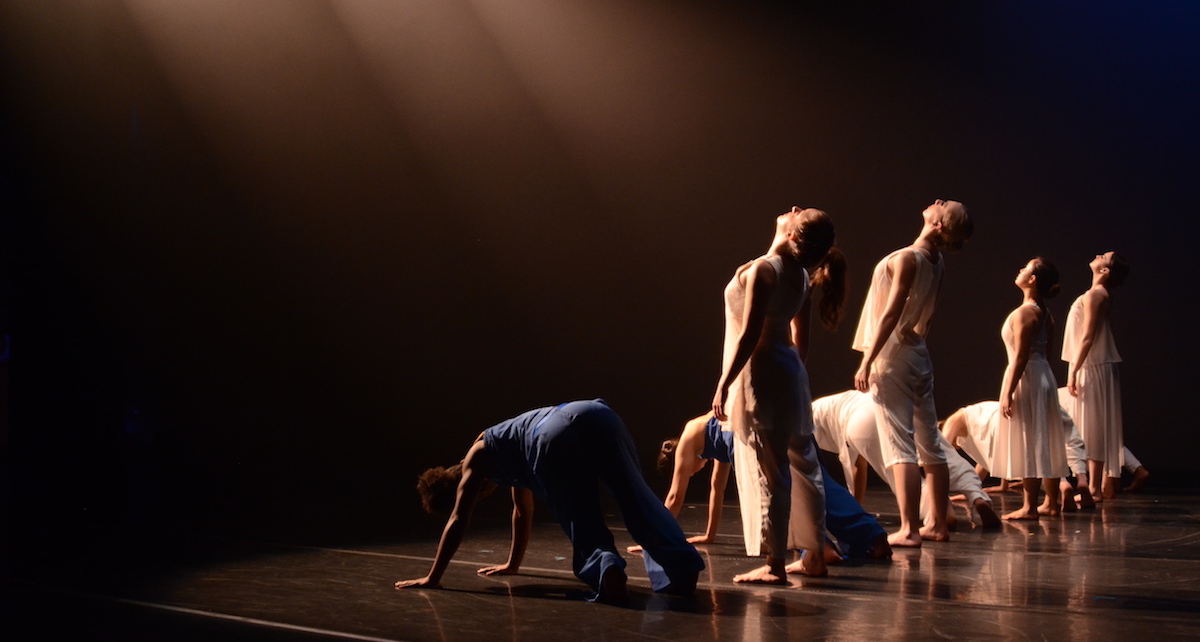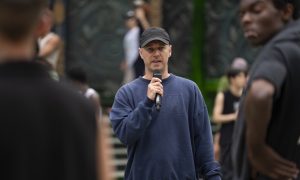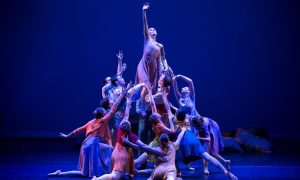Dance Informa continues its series on second companies with a spotlight on Dayton Contemporary Dance Company 2.
More than four decades ago, Dayton Contemporary Dance Company (DCDC) founder Jeraldyne Blunden recognized a lack of preparation among young dancers entering the professional world. She understood the importance of stage time and knew many dancers left their high school studio and college program with minimal performance experience under their belt. Even today, the life of a professional dancer can feel like a trial by fire. Compare DCDC’s 50 to 75 annual performances to the average college dance program’s once-a-semester concert schedule. A visionary leader, Blunden sought to bridge the gap between the pre-professional and professional world.
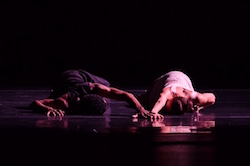
DCDC2 in performance. Photo by Scott Robbins of Geek with a Lens.
Dayton Contemporary Dance Company 2 (DCDC2), established by Blunden in 1975, became that bridge. “It all goes back to the training ground,” says Shonna Hickman-Matlock, director of education and outreach at DCDC. Like an apprenticeship, the second company – also called the junior company or the pre-professional ensemble – provides dancers with the opportunity to continue their study in a small, company-like setting without the hefty time commitment of national tours and all-day rehearsals. In fact, DCDC2 partners with two local universities, the University of Dayton and Wright State University, and many of its members are college students seeking real-world performance experience while earning their degree.
Hickman-Matlock, who also oversees the DCDC2 program, says they want second company members to “see the fruits of their labor.” Dancers commit to 20 hours per week, with daily classes in ballet, modern and jazz – most taught by current and former main company members – followed by rehearsal. At any given time, the dancers rehearse two or even three programs for main stage and lecture demonstration performances in the community. “They become invested in learning quickly,” says Hickman-Matlock. With a broad range of choreographic styles in their repertory, DCDC2 dancers hone their listening skills and learn to become “astute observers” of movement.
Thus, the second company’s mission is twofold: to prepare the dancer for DCDC, a repertory company devoted to preserving each guest choreographer’s process and vision, and to make dancers more employable by stressing the importance of versatility. In addition, DCDC2 maintains a presence in the Dayton community when the main company is on tour, generating revenue for the organization through ticketed events. Although second company members do not receive a salary, participation provides invaluable performance experience, mentorship and free classes.
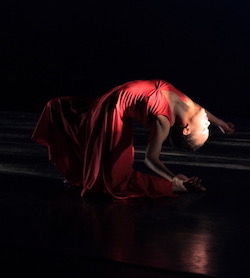
DCDC2 dancer. Photo by Scott Robbins of Geek with a Lens.
DCDC2 stands apart from other second companies in its dedication to nurture the whole artist. “When we see an ember, we try to foster it until it becomes a blaze,” says Hickman-Matlock. True to Blunden’s vision for the company, dancers who show an aptitude or interest in choreographing or teaching are given opportunities to further their craft. Hickman-Matlock recently recognized a creative voice in Wright State graduate and DCDC2 company member Elizabeth Ramsey. Ramsey has since been asked to set one of her works on the second company for performance.
Oftentimes dancers think of second companies as “feeder schools”, but DCDC2 makes it clear that the main company is just one of many options. Hickman-Matlock, along with DCDC’s artistic and associate directors, sits down with dancers regularly to evaluate their progress as well as their career aspirations. The advisory team asks if the dancer is interested in the main company but also offers viable alternatives (including upcoming auditions) tailored to the individual. Five of DCDC’s current 12 main company dancers transitioned from DCDC2, but graduates of the second company have also joined a diverse range of companies and casts, including Urban Bush Women, Hubbard Street Dance Chicago, Parsons Dance Company, and the touring Broadway productions of Wicked and Movin’ Out.
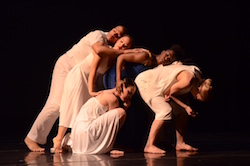
DCDC2 dancers. Photo by Scott Robbins of Geek with a Lens.
In a supportive environment, dancers in a second company can test the waters before they jump in. Some can hang, says Hickman-Matlock, and others can’t; or they come to the realization that their heart lies with something else: another performance track, graduate school, or a different career entirely. For companies and dancers alike, DCDC2 provides a sort of extended audition period, where dancers can decide if they like DCDC’s vibe and the company directors can assess work ethic, improvement and ability to mesh with the group.
With its long hours, grueling touring schedules, and wear and tear on the body, professional dance isn’t for everyone. Second companies, especially those like DCDC2 that provide plenty of opportunities to interact with main company members, offer a window into the future; dancers can then make informed decisions that lead to happy and healthy performance careers.
By Kathleen Wessel of Dance Informa.


